Intel’s 11th Gen Core Tiger Lake SoC Detailed: SuperFin, Willow Cove and Xe-LP
by Dr. Ian Cutress on August 13, 2020 9:01 AM EST- Posted in
- CPUs
- Intel
- SoCs
- Tiger Lake
- 10+
- Xe-LP
- Willow Cove
- Intel Arch Day 2020
- SuperFin
- 10SF
What is Xe-LP?
A big part of the Tiger Lake/Ice Lake comparison will be the performance difference in graphics. Where Ice Lake has 64 Execution Units of Gen11 graphics, Tiger Lake has 96 Execution Units but of the new Xe-LP architecture. On top of that, there’s the new SuperFin transistor stack that promises to drive frequencies (and power windows) a lot higher, making Tiger Lake more scalable than before.
Straight off the bat Intel’s graphs are showing that at the same voltage, where Ice Lake Gen11 achieves 1100 MHz, the new Xe-LP graphics will get to ~1650 MHz, a raw +50% increase. That means at Ice Lake’s peak power, we should expect Tiger Lake to perform at a minimum 2.25x better. Expanding beyond that, the peak for Tiger Lake seems to be in the 1800 MHz range, ultimately giving a minimum 2.45x more performance over Ice Lake. This is before we even start talking about the fundamental differences in the Xe-LP architecture compared to Gen11.
Intel is promoting Xe-LP as operating at 2x the performance of Gen11, so even though these numbers might easily suggest a 2.25x uplift before taking into account the architecture, it will ultimately depend on how the graphics is used.
Gen11 vs Xe-LP
For a more in-depth look into Intel’s Xe graphics portfolio, including HP, HPC, and the new gaming architecture HPG, Ryan has written an article covering Xe in greater detail. In this article, we’ll cover the basics.
In the Ice Lake Gen11 graphics system, each one of the 64 execution units consisted of two four-wide ALUs, one set of four for FP/INT, and the other set of four for FP/Extended Math. 16 of these execution units would form a sub-slide within Gen11.
For Xe-LP, that 4+4 per execution unit has been rebalanced for this target market. There are now 10 ALUs per execution unit, but in an 8+2 configuration. The 8 ALUs support 2xINT16 and INT32 data types, but also with new DP4a instructions can accelerate INT8 inference workloads. The new execution units also now work in pairs – two EUs will share a single thread control block to help assist with coordinated workload dispatch.
As with ICL, 16 of the EUs now form a sub-slice with the graphics, and slices are added in the SoC as performance is needed. What is new in Tiger Lake is that each sub-slice now has its own L1 data and texture cache, and the pixel backend runs 8 pixels/clock per two sub-slices.
Overall the graphics system can support 1536 FLOP/clock, with the samplers at 48 Tex/clock per sub-slice and a total of 24 pixel/clock in the back-end. LP in Tiger Lake has 16 MiB of its own L3 cache, separate from the rest of the L3 cache in the chip, and the interface to the memory fabric is doubled, supporting 2x64B/clock reads or writes or a combination of both.
Exact performance numbers for Xe-LP in Tiger Lake are going to be a question mark until we get closer to launch. Intel has stated that the discrete graphics version of LP, known as DG1, is due out later this year.
Xe-LP Media and Display
The other question on Tiger Lake on graphics will be the media and display support. Tiger Lake will be Intel’s first official support for the AV1 codec in decode mode, and Intel has also doubled its encode/decode throughput for other popular codecs. This means a full hardware-based 12-bit video pipeline for HDR and 8K60 playback support.
Display Support for Tiger Lake is also extended with four 4K display pipelines. Connections over DP1.4, HDMI 2.0, Thunderbolt 4, and USB4 Type-C simultaneously is how Intel expects users to operate if all four outputs are needed at once. The display engine also supports HDR10, 12-bit BT2020 color, Adaptive Sync, and support for monitors up to 360 Hz.
External Graphics and Hybrid Support
One of the interesting questions we posted to Intel during Architecture Day was surrounding how Xe-LP will operate in the presence of additional graphics, and potentially paired with a discrete version of LP later in the year. Unfortunately there seemed to be some confusion between the definitions of ‘hybrid’ graphics vs ‘switchable’ graphics, so we got that cleared up in time for the article.
At present, Intel expects almost all Tiger Lake solutions to run in devices where there is no discrete graphics solution – only the integrated graphics is provided as the primary compute for gaming and acceleration. However, Tiger Lake will support switchable graphics solutions with Xe-LP discrete graphics. Intel did not state if this was discrete graphics with respect to a built LP chip or an external discrete graphics solution through Thunderbolt.
Due to Tiger Lake’s PCIe 4.0 support and Thunderbolt 4 support, depending on how an exact Tiger Lake system is configured, Intel expects that any discrete graphics solution will operate at a lower latency, mostly due to the fact that the PCIe 4.0 lanes will be directly attached to the CPU, rather than a chipset. Intel quoted ~100 nanosecond lower latency. They also stated an 8 GB/s bandwidth to main memory, which seemed a bit low?
On the topic of hybrid graphics, where the integrated graphics and an Xe-LP discrete solution could work in tandem on the same rendering task, Intel stated that there is no plan to support a Multi-GPU solution of this configuration.


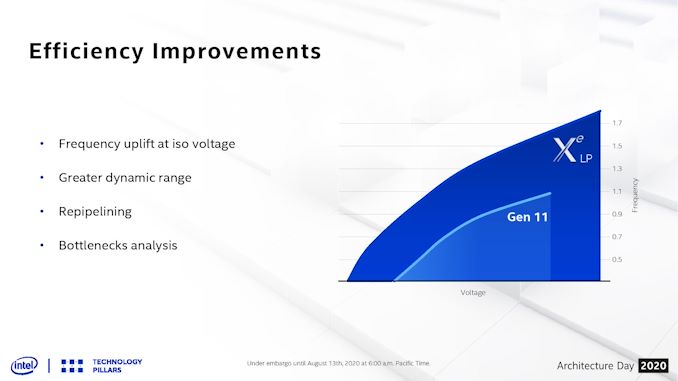
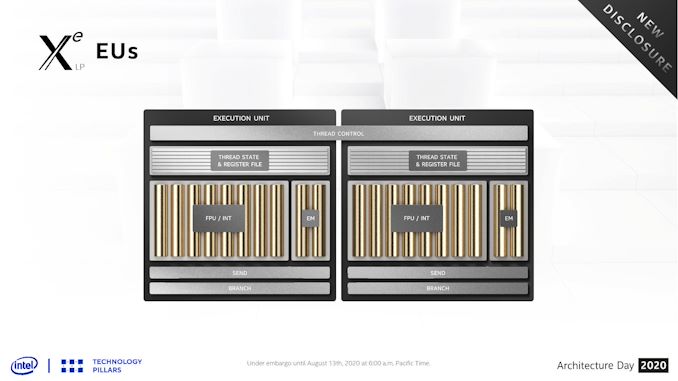
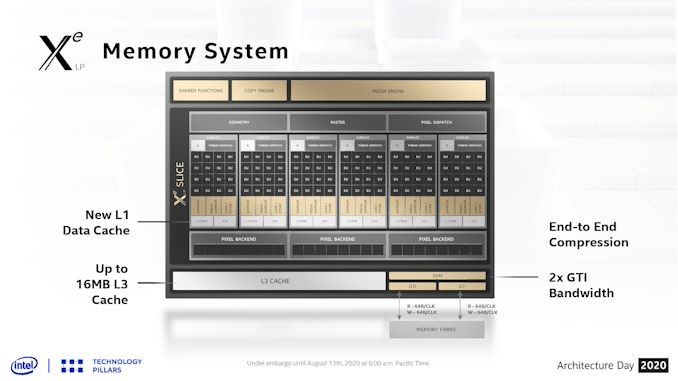
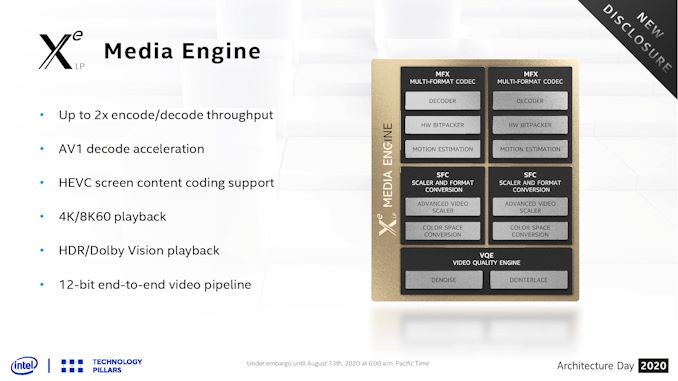
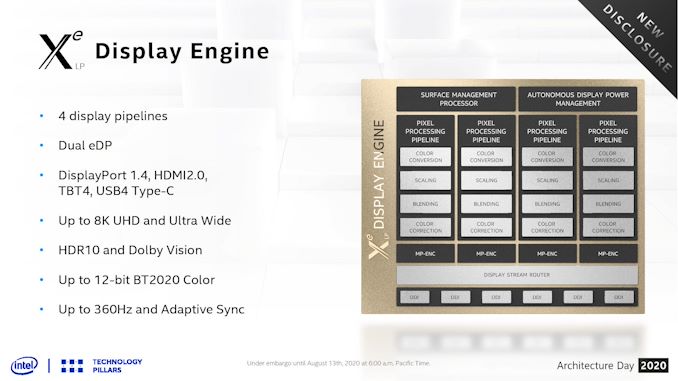








71 Comments
View All Comments
Everett F Sargent - Thursday, August 13, 2020 - link
When you have epic fails at 10mn and 7nm for anything above 45W what does one do? One so-called changes their three-card Monte scheme to ... Redefining the FinFET!14++++?
Alder Lake should be renamed Lava Lake to be followed by a 10++++ desktop part circa 2030 called Hades Lake and a 7+++ part circa 2040 called Crater Lake.
In fact. all their nodes should be re-branded with Moon crater names. That way they can stop digging ever deeper holes for themselves.
TristanSDX - Thursday, August 13, 2020 - link
"As part of Architecture Day 2020, Intel also stated that the intranode update beyond 10SF will be called 10ESF," - so there won't be 10+, 10++, 10+++, but 10SF, 10ESF, 10EESF,...For me + are better
shabby - Thursday, August 13, 2020 - link
I think intel is just tired of the 14nm++++++++++ jokes so they're making a new one.jospoortvliet - Saturday, August 15, 2020 - link
So it is Enhanced Super Fins, Extra Enhanced, Enormous Extra Enhanced, Epically Enormous Extra Enhanced...Linustechtips12#6900xt - Wednesday, April 7, 2021 - link
I think you forgot about EXTREME Xtra enormous enhanced PRO MAX SUPER finsArbie - Thursday, August 13, 2020 - link
An excellent article as usual, and clearly a great deal of work. Thanks.Meteor2 - Tuesday, August 18, 2020 - link
SecondedKimGitz - Thursday, August 13, 2020 - link
I'm really waiting for Tiger Lake H which I think will go upto 8cores and feature LPDDR 5. I'm really hoping the next Microsoft Surface Book 4 will feature it and finally also support Thunderbolt for the first time. Tiger Lake H would make the Surface Book practical and functional when the screen is detached. If you look at the price tag of Surface Book they can pass on the cost of LPDDR 5 on a $3000 device. Laptops using Tiger Lake H can be paired mobile discrete GPU. The PCIe 4.0x4 available for fast NVME SSD storage directly from the CPU will bridge the gap between next gaming consoles. Booting up will be instant. Unfortunately we have to wait until 2021 for Tiger Lake H. On the other hand Chrome OS is going to really benefit from Tiger Lake U with the iGPU improving things. I expect to see a lot of Chromebooks and Chrome 2in1.Stahlkocher - Thursday, August 13, 2020 - link
How much more expensive can LPDDR5 really be? S20 series, OnePlus 8 series, Xiaomis Mi 10 (Pro) and at least one phone from Realms and Redmi do ready use LPDDR5.If that is already possible with phones it should also be possible with premium notebook designs.
KimGitz - Thursday, August 13, 2020 - link
The problem as far as I can tell is volume, mobile phones push more devices so they can benefit from the economy of scale. Samsung with their Exynos 990 and Qualcomm Sanpdragon 865 SOCs support LPDDR5 with around a dozen smartphones out (half from Samsung). Samsung who are leading in manufacturing LPDDR5 memory only uses it on their flagship mobile devices because they will sell millions of smartphones compared to laptops. Now that Intel supports LPDDR5 we will see an increased demand and roll out on laptops.